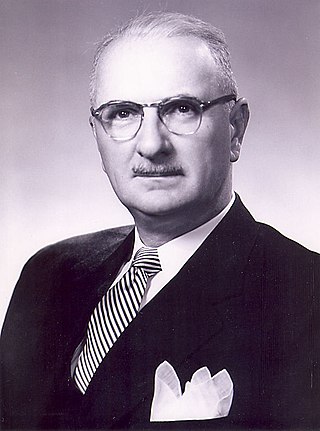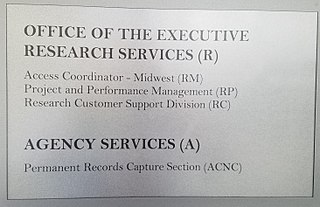
The Purple Heart (PH) is a United States military decoration awarded in the name of the President to those wounded or killed while serving, on or after 5 April 1917, with the U.S. military. With its forerunner, the Badge of Military Merit, which took the form of a heart made of purple cloth, the Purple Heart is the oldest military award still given to U.S. military members. The National Purple Heart Hall of Honor is located in New Windsor, New York.

St. Louis is the second-largest city in Missouri, United States. It is located near the confluence of the Mississippi and the Missouri rivers. In 2020, the city proper had a population of 301,578, while its bi-state metropolitan area, which extends into Illinois, had an estimated population of over 2.8 million. It is the largest metropolitan area in Missouri and the second largest in Illinois.

The United States Department of State (DOS), or simply the State Department, is an executive department of the U.S. federal government responsible for the country's foreign policy and relations. Equivalent to the ministry of foreign affairs of other nations, its primary duties are advising the U.S. president on international relations, administering diplomatic missions, negotiating international treaties and agreements, and representing the U.S. at the United Nations. The department is headquartered in the Harry S Truman Building, a few blocks from the White House, in the Foggy Bottom neighborhood of Washington, D.C.; "Foggy Bottom" is thus sometimes used as a metonym.

The National Geospatial-Intelligence Agency (NGA) is a combat support agency within the United States Department of Defense whose primary mission is collecting, analyzing, and distributing geospatial intelligence (GEOINT) in support of national security. Initially known as the National Imagery and Mapping Agency (NIMA) from 1996 to 2003, it is a member of the United States Intelligence Community.

Military police (MP) are law enforcement agencies connected with, or part of, the military of a state. In wartime operations, the military police may support the main fighting force with force protection, convoy security, screening, rear reconnaissance, logistic traffic management, counterinsurgency, and detainee handling.

The Republic of Vietnam Gallantry Cross also known as the Vietnamese Gallantry Cross or Vietnam Cross of Gallantry is a military decoration of the former Government of South Vietnam. The medal was created on August 15, 1950, and was awarded to military personnel, civilians, and Armed Forces units and organizations in recognition of deeds of valor or heroic conduct while in combat with the enemy.

The National Personnel Records Center fire of 1973, also known as the 1973 National Archives fire, was a fire that occurred at the Military Personnel Records Center in the St. Louis suburb of Overland, Missouri, from July 12–16, 1973.
A military base is a facility directly owned and operated by or for the military or one of its branches that shelters military equipment and personnel, and facilitates training and operations. A military base always provides accommodations for one or more units, but it may also be used as a command center, training ground or proving ground. In most cases, military bases rely on outside help to operate. However, certain complex bases are able to endure on their own for long periods because they are able to provide food, water, and other necessities for their inhabitants while under siege. Bases for military aviation are called military air bases, or simply "air bases". Bases for military ships are called naval bases.

The Defense Logistics Agency (DLA) is a combat support agency in the United States Department of Defense (DoD), with more than 26,000 civilian and military personnel throughout the world. Located in 48 states and 28 countries, DLA provides supplies to the military services and supports their acquisition of weapons, fuel, repair parts, and other materials. The agency also disposes of excess or unusable equipment through various programs.
The Military Personnel Records Center (NPRC-MPR) is a branch of the National Personnel Records Center and is the repository of over 56 million military personnel records and medical records pertaining to retired, discharged, and deceased veterans of the U.S. armed forces.

Tricare is a health care program of the United States Department of Defense Military Health System. Tricare provides civilian health benefits for U.S Armed Forces military personnel, military retirees, and their dependents, including some members of the Reserve Component. Tricare is the civilian care component of the Military Health System, although historically it also included health care delivered in military medical treatment facilities. Tricare functions similar to a single-payer healthcare system.
The DD Form 214, Certificate of Release or Discharge from Active Duty, generally referred to as a "DD 214", is a document of the United States Department of Defense, issued upon a military service member's retirement, separation, or discharge from active duty in the Armed Forces of the United States.
A service record is a collection of either electronic or printed material which provides a documentary history of a person's activities and accomplishments while serving as a member of a given organization. Service records are most often associated with the military, but are commonly found in other groups, such as large corporations or for use by employees of a civilian government.

The Missouri Air National Guard (MO ANG) is the aerial militia of the State of Missouri, United States of America. It is, along with the Missouri Army National Guard, an element of the Missouri National Guard.

This article incorporates public domain material from websites or documents of the United States Army.

Lester DeWitt Mallory was an American diplomat.

Colonel Stanley Andrews was a journalist and U.S. Army officer from Missouri who headed both the Office of Foreign Agricultural Relations of the U.S. Department of Agriculture and the Technical Cooperation Administration of the U.S. Department of State. Colonel Andrews was a veteran of both World War I and World War II. Andrews wrote an unpublished memoir, Journal of a Retread, a copy of which he donated to the Truman Presidential Library along with transfer of its copyright to the public domain.

In the United States, the National Archives facilities are facilities and buildings housing the research and agency services of the country's National Archives and Records Administration. Within the organization of the National Archives, the upkeep of its facilities falls under the National Archives Facilities and Property Management Office.

The organization of the National Archives and Records Administration refers to the administrative and bureaucratic structure of the National Archives and Records Administration of the United States. The National Archives is considered an independent federal government agency, receiving this status in 1985 after existing under the General Services Administration since the National Archives' founding in 1934.
The Demobilized Personnel Records Center (DPRC) was an installation of the United States Army which operated in St. Louis, Missouri from 1945 to 1956. The facility was housed in the former Goodfellow ordnance plant in St. Louis and became the central repository for all service records of discharged service members of the United States Army.















